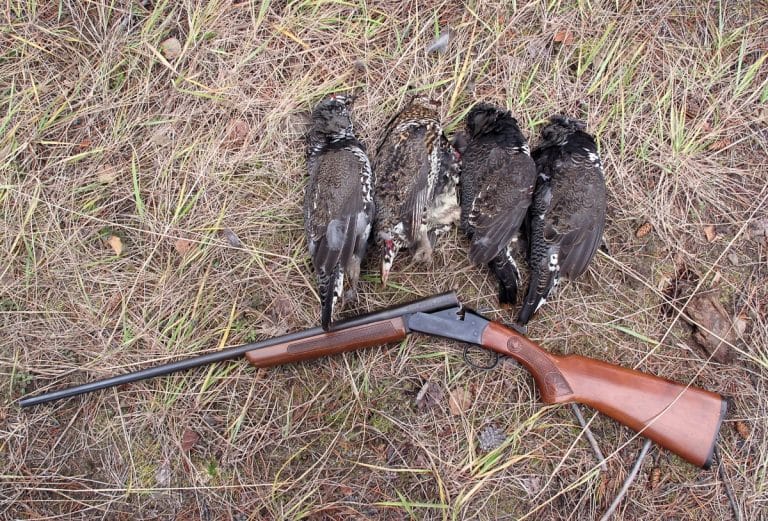So someone you know wants to learn to hunt; good for them! Or perhaps you want to teach one of your kids, or even your spouse. Well, here in the Pacific Northwest of North America, the best place to start someone is hunting grouse. Grouse hunting has been a staple of hunters all over the world for about as long as hunting has existed. And many, if not most, hunters will tell you that the first game their parents introduced them to when learning to hunt was grouse. Why is that, you ask? Because the very nature of these wild chickens lends them to be the perfect game bird for new and novice hunters. Better than that, though, grouse hunting often remains a staple for most hunters throughout their lifetime. Since I live and hunt in the northwest, I will detail the birds I am familiar with. Let me introduce you to some of these fine game birds and why they make such perfect quarry.

Most Common Species of Grouse
The most prolific of grouse is the ruffed grouse, so called because of the ruff of feathers around its neck that the males puff out like a peacock’s tail during their mating rituals. It inhabits the forests of almost all the Canadian provinces as well as many of the northern states. Also known as the willow, or drumming grouse, the ruffed is a worthy quarry and a delicious game bird. These birds can often be heard in the spring as a distant drumming in the forest. It sounds a lot like an old farm tractor trying to start up. The sound is actually caused by the males standing on their drumming logs and beating their wings against the air. They do this to attract hens from afar.
Ruffed Grouse
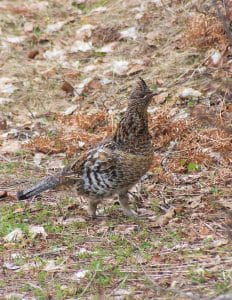
Ruffed grouse are a fair-sized bird about the size of a small chicken. Overall, they are mottled brown and sport a short crest of feathers on top of their heads. Mature adults also have a characteristic black band across the tips of the tail feathers, making them easily identifiable. They inhabit a wide range of habitats and seem to be as comfortable in coastal rainforests as they are in interior pine forests, but they prefer forests to open range. Ruffed grouse love berries. Wherever you find large areas of scattered berry plants, such as salal, there is sure to be some ruffed grouse in the area.
Sooty Grouse
The Sooty grouse is one of the largest of the grouse and inhabits the coastal forests. Its close variant, the Dusky grouse, lives in the Rocky Mountain areas of both countries, from the Yukon Territory to as far south as New Mexico. Until a few years ago, these two birds were considered to be one species, the Blue grouse, but recent research has split them into two separate variants. The Sooty grouse, as the name implies, is sooty gray in color overall. During courtship, they reveal orange eye combs and yellow-orange air sacs in the neck.
Dusky Grouse
The Dusky grouse males are steely gray-blue with purplish air sacs in the neck and dark orange eye combs that they show off to attract the hens in the mating season. Common to both species is that their legs and feet are covered with feathers, unlike the Ruffed grouse. Both also make loud hooting sounds during courting. They are big birds and the mature males can weigh up to four pounds.
These birds like higher elevations within their native ranges; you won’t find them down low in the valleys. They feed mostly on coniferous needles and buds, as well as insects and berries when they can find them. Interestingly enough, as winter settles in and the snows get heavier, they actually move to denser forests. This is because the heavier canopies provide better cover, and the lower branches of the trees don’t collect as much snow, so the needles remain available to grouse as food.
Spruce and Franklin Grouse
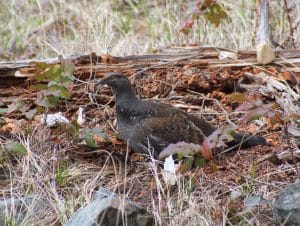
The Spruce and Franklin’s grouse are almost identical in appearance, so much so that some scientists classify the Franklin’s grouse as a subspecies of the Spruce grouse, although most still consider them separate species. Because they rely heavily on their camouflage, they tend to hold to cover very well and are often referred to as the classic “fool hen”. The Spruce and Franklin’s grouse are much smaller than their cousins, the Dusky and Sooty grouse, usually weighing in at about 1½ pounds. Both the males and females are quite dark in color overall, and this can lead to identification problems between them and the Dusky and Sooty grouse, where their ranges overlap. However, the Dusky and Sooty grouse are much larger, and the males sport an orange comb over their eyes, whereas the Spruce grouse males have a red comb over their eyes. Spruce and Franklin’s grouse also prefer the higher altitude forests, and their main diet consists of pine, spruce, fir, and balsam needles.
Sharptail Grouse
Arid open grasslands are home to the sharptail grouse. These birds are often referred to as prairie chickens, but in fact, the prairie chicken is an entirely different species. Sharptail grouse are short, plump birds with short, sharp tails. The two center tail feathers are significantly longer than the others and thus give the appearance of a sharp tail, which gives the bird its name. They survive best in areas where there are large tracts of rolling, hilly land occupied with native vegetation, broken up by the occasional brushy draw or cultivated field. Sharptails feed on a wide variety of things, including grass and weed seeds, insects, and the fruit from various shrubs and trees. This wide palate is one of the reasons why they are able to survive the winters.
Additional Grouse Sub-species
Several additional species of grouse exist in North America. Here is a list of the species and subspecies available to hunters. Depending on your location, you can find information about these on the Cornell University Ornithology Lab.
- Sage Grouse – Greater and Gunnison
- Prairie Grouse – Sharptail, Alaska Sharptail, Columbian Sharptail, Northwestern Sharptail, Northern Sharptail, and Plains Sharptail
- Prairie Chicken – Attwater’s Prairie Chicken, Greater and Lesser Prairie Chicken
- Ptarmigan – Rock Ptarmigan, Willow Ptarmigan, and Whitetailed Ptarmigan
Gearing Up for Grouse Hunting
Regardless of where you live or plan to hunt, personal gear for hunting grouse is pretty much the same. Temperature at any given time of year will dictate what type of clothing you’ll need to wear, as will the amount and kind of precipitation you’ll be hunting in.
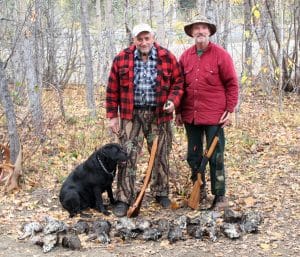
Good, sturdy, weatherproof upland hunting boots with adequate ankle support and good traction are necessary. Most grouse hunting requires at least some walking, usually over varied terrain, and there’s nothing more miserable than spending a day trying to walk with wet, blistered feet. I can’t stress this enough; go prepared or you’ll be sorry.
Because you may be humping it through the woods and fields or down the old abandoned logging roads, you’re going to be exerting a significant amount of effort at various times of the day. This means that you’re going to heat up and cool down. With this in mind, be sure to wear various layers of clothes and take a small backpack or rucksack along. This way, you can doff or don clothes as needed. The rucksack is also very handy for packing a lunch, water for you and your dog, ammunition, and any birds you bag. You will appreciate good hunting pants that can take a beating while walking through the brush.
On an average cool fall day your first layer of clothes should be something that will wick away the sweat. Over that a pair of good, rugged pants and a flannel shirt should do just fine. Finally a weatherproof jacket of some sort that is light and sturdy but still allows you to move well and good pair of boots as described above should put you in good stead for the day.
Best Firearms for Grouse Hunting
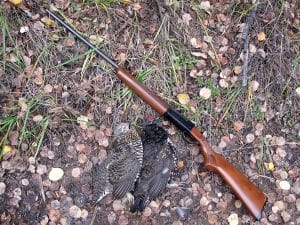
A variety of firearms are used to hunt grouse. Everything from 12-gauge shotguns to .22 caliber rifles is used and, in the right hands, are effective in a variety of conditions and terrains. For those hunters who concentrate on grouse, a .410 or 20 gauge shotgun seems to be the firearm of choice. For those of us who can’t afford multiple firearms but like to hunt various game birds, there is probably nothing better than the ubiquitous 12 gauge shotgun. In most states and provinces, .22 rifles are legal for hunting grouse as well. The .22 can be highly effective in open terrain where grouse, such as the blue grouse, often roost on tree branches or on the tops of large stumps, making them easy targets for any relatively good shot.
Ammunition for Grouse Hunting
As far as the best ammunition goes, No. 6 lead or No. 5 steel shot are the recommended loads for a 12 or 20 gauge; 71/2 shot is best in a .410. Especially for beginners, though, you should take your shotgun to the range and pattern it using a variety of shot sizes so that you can determine which load gives you the best overall pattern at various ranges. Most grouse like to go to ground when frightened and rely on their camouflage to hide themselves. They flush only when you get into close proximity, and some, like the Dusky, Sooty, and Spruce, often won’t flush unless they are almost stepped on. This proximity flushing often comes as a surprise to the hunter, and so not only do you have to react quickly and get a shot off, but you have to quickly recover from the surprise of the bird flushing very close to you. A good gun dog can work wonders here.
Getting a Shot at a Flushed Grouse
When flushed, grouse generally prefer to fly and glide downhill. Ruffed grouse will usually land back on the ground, but the Dusky, Sooty, and Spruce grouse are as likely as not to land in the lower branches of the trees, making them easy targets if you keep your eyes on them as they fly. Unfortunately, flying downhill puts the hunter at a disadvantage because as the bird flies further away, the crowns of smaller trees quickly get in the way, whereas if the birds were to fly uphill, the hunter would have the advantage of looking underneath most of the live branches.
Because the majority of grouse here inhabit forest areas, hunters often have to bush crash to find birds. The birds flush close and head downhill, immediately putting as many trees between them and the hunters as fast as possible. Not only is this a problem, but the hunter is often standing within touching distance of branches all around him. Due to these factors, the best firearms for hunting grouse have shorter barrels. Shorter barrels help the hunter avoid banging the barrel against a branch while swinging onto a flushing bird. Good bush guns for grouse have 26-inch or shorter barrels. The short barrels allow for fast swings and quicker shots than the standard 30-inch shotgun barrels. And here is another good tip: while you are at the range, patterning your shotgun practice, snap shooting so that you can be familiar with how to get quick, accurate shots off before the flushing bird puts too many trees between you and it.
Grouse Hunters, Get in Shape
Hunting grouse often requires a significant amount of walking, quite often through undulating, brushy terrain. You have to be in at least moderately good physical shape to do this. You can have the best equipment, but it won’t do you any good if you can’t walk uphill for a couple of hundred meters without passing out. So take the time during the summer to get off the couch and start walking. As a matter of fact, you can combine your walking with scouting out the areas that you may want to hunt.
How to Find Grouse
Preseason scouting is key to being successful when grouse hunting. At least three of the species give themselves away during mating season while still a very long way off. The ruffed grouse drumming and the Dusky and Sooty grouse hooting can be heard from far off, and you can bet that if you hear them, there will be more in the area. You can also make a few phone calls or stop in at a couple of offices of the various forest companies in your area and talk to them about where the best places might be to pursue grouse. Not only that, but you should make a point of talking to your local conservation officers. They will often give you good information as to where you might find grouse, and of course, they will steer you to the areas where you can legally hunt them. It’s particularly important that you do your homework before the season arrives; if you don’t, there is a high likelihood that you will spend many hours hunting areas that have very few, if any, birds. Do your research; it’ll pay big dividends in the end.
Road Hunting for Grouse
There is one other method for effective grouse hunting, and that is road hunting. Road hunting is legal where I live, and I do it quite a bit. So do many others. As long as you do it correctly and safely, you won’t have any problems. Remember that road hunting means hunting old abandoned logging roads that are partially grown over with little or no traffic. It doesn’t mean hunting major thoroughfares or regularly traveled roads. Old abandoned logging roads are favorite places for grouse. Grouse like old roads because they offer good concentrations of gravel for them to fill their crops. Also, the old roads quite often offer the birds good dusting areas. Just keep in mind that it is illegal to travel in a vehicle with a loaded firearm. This means that ammunition cannot be chambered or in the magazine if the magazine is attached to the firearm. You can, however, have a loaded magazine if it is detached from the firearm. If you’re going to road hunt, then you should try to practice getting out of your vehicle safely with your shotgun or .22 and then loading once you are clear of the door. Especially on old roads, be aware of what’s past the bird. You don’t want to discharge a firearm when a vehicle or person could possibly come around the bend at the wrong time. So be smart and stay safe and legal.
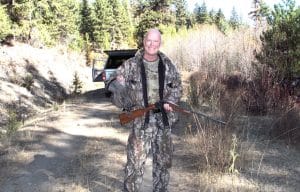
I love grouse hunting it gets me outside and closer to nature, lets me work with my dog, and can very often put food on the table, which is quite delicious by the way. You should give it a try. I believe it is the best way to introduce a young hunter to the sport. It worked for me.
Per our affiliate disclosure, we may earn revenue from the products available on this page. To learn more about how we test gear, click here.



